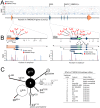Genetic testing for TMEM154 mutations associated with lentivirus susceptibility in sheep
- PMID: 23408992
- PMCID: PMC3569457
- DOI: 10.1371/journal.pone.0055490
Genetic testing for TMEM154 mutations associated with lentivirus susceptibility in sheep
Abstract
In sheep, small ruminant lentiviruses cause an incurable, progressive, lymphoproliferative disease that affects millions of animals worldwide. Known as ovine progressive pneumonia virus (OPPV) in the U.S., and Visna/Maedi virus (VMV) elsewhere, these viruses reduce an animal's health, productivity, and lifespan. Genetic variation in the ovine transmembrane protein 154 gene (TMEM154) has been previously associated with OPPV infection in U.S. sheep. Sheep with the ancestral TMEM154 haplotype encoding glutamate (E) at position 35, and either form of an N70I variant, were highly-susceptible compared to sheep homozygous for the K35 missense mutation. Our current overall aim was to characterize TMEM154 in sheep from around the world to develop an efficient genetic test for reduced susceptibility. The average frequency of TMEM154 E35 among 74 breeds was 0.51 and indicated that highly-susceptible alleles were present in most breeds around the world. Analysis of whole genome sequences from an international panel of 75 sheep revealed more than 1,300 previously unreported polymorphisms in a 62 kb region containing TMEM154 and confirmed that the most susceptible haplotypes were distributed worldwide. Novel missense mutations were discovered in the signal peptide (A13V) and the extracellular domains (E31Q, I74F, and I102T) of TMEM154. A matrix-assisted laser desorption/ionization-time-of flight mass spectrometry (MALDI-TOF MS) assay was developed to detect these and six previously reported missense and two deletion mutations in TMEM154. In blinded trials, the call rate for the eight most common coding polymorphisms was 99.4% for 499 sheep tested and 96.0% of the animals were assigned paired TMEM154 haplotypes (i.e., diplotypes). The widespread distribution of highly-susceptible TMEM154 alleles suggests that genetic testing and selection may improve the health and productivity of infected flocks.
Conflict of interest statement
Figures



References
-
- Thormar H (2005) Maedi-visna virus and its relationship to human immunodeficiency virus. AIDS Rev 7: 233–245. - PubMed
-
- Blacklaws BA, Berriatua E, Torsteinsdottir S, Watt NJ, de Andres D, et al. (2004) Transmission of small ruminant lentiviruses. Vet Microbiol 101: 199–208. - PubMed
-
- Peterhans E, Greenland T, Badiola J, Harkiss G, Bertoni G, et al. (2004) Routes of transmission and consequences of small ruminant lentiviruses (SRLVs) infection and eradication schemes. Vet Res 35: 257–274. - PubMed
-
- Sigurdsson B, Grimsson H, Palsson PA (1952) Maedi, a chronic, progressive infection of sheep’s lungs. J Infect Dis 90: 233–241. - PubMed
Publication types
MeSH terms
LinkOut - more resources
Full Text Sources
Other Literature Sources
Medical
Miscellaneous

